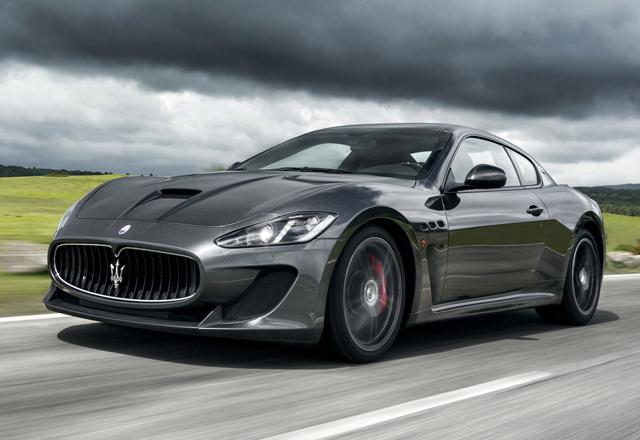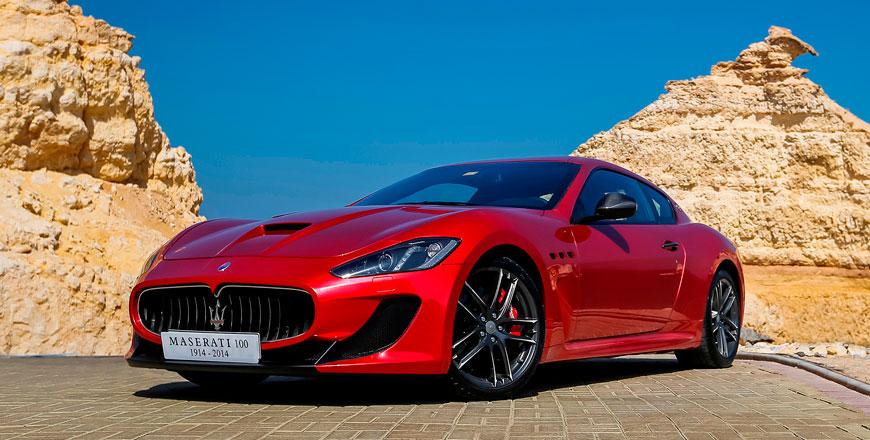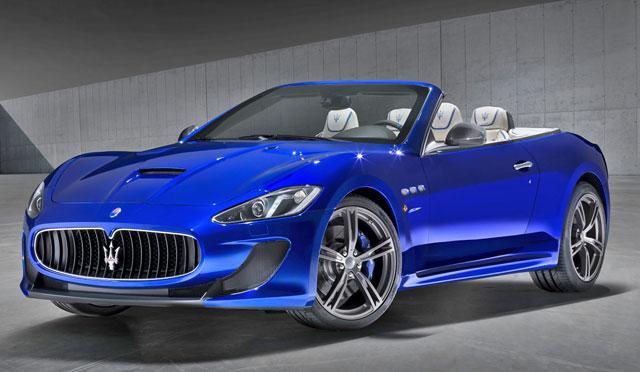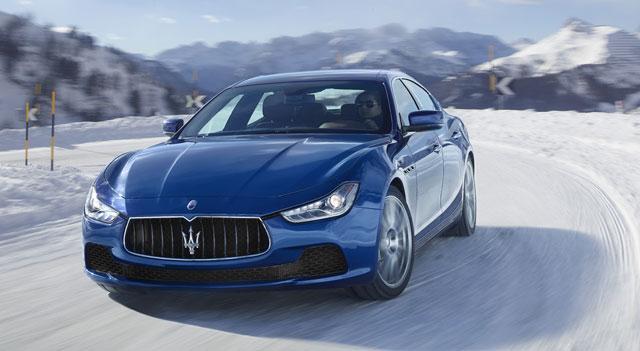You are here
Trident missile
By Ghaith Madadha - Jun 23,2014 - Last updated at Jun 23,2014

AMMAN — With the right mix of showmanship, visceral thrills and beauty, the Maserati GranTurismo MC Stradale is a thing of pure passion.
Classier car than most exotic sports and luxury cars, the GranTurismo MC Stradale oozes grace and menace in equal measure from every metaphoric pore of its salaciously voluptuous body.
With seductively burbling engine, robotised manual gearbox, iconic Neptune’s Trident badge, lush interior and striking aesthetics, the MC Stradale enjoys an extravagantly — but never vulgar — caddish charm and louche indulgence.
Though a replacement — likely similar to this year’s Maserati Alfieri concept — is in the pipelines, the MC Stradale remains as abundantly charismatic as ever.
Celebrating its centenary this year Maserati’s motorsport, luxury and design elements of its rich heritage converge harmoniously in the form of the revised 2014 GranTurismo MC Stradale.
The fastest, lightest and best handling version of the GranTurismo model line, the MC Stradale was developed in response to customer demand for road legal super sports version of Maserati’s sultry grand tourer (GT) that bore greater resemblance to Trofeo and other race versions.
First introduced as a two-seat 2011 model, the revamped MC Stradale gains 10BHP and ditches the roll cage for practical rear seats better suited to a focused but luxurious GT, rather than all-out track car.
Seductive style
A devilishly handsome Trident-bearing super sport GT, the Pininfarina-penned MC Stradale‘s swooping lines and aesthetic proportions are tastefully extrovert and debonair.
Built on a shortened previous generation Quattroporte luxury saloon platform, the 4.9-metre long and 1.9-metre wide GranTurismo is a large four-seat two-door GT that hides its size well with gorgeously flowing and cohesive lines, delicately sultry contours and massive 255/35ZR20 front and 295/35ZR20 rear footwear filling its voluptuous wheel-arches.
With classic sports car proportions, a low-mounted front mid-mounted engine nestles under the MC Stradale’s curvaceously and extravagantly long bonnet while its rearwards cabin straddles a rear transaxle gearbox for near perfect 52 per cent rear-biased weighting.
With near tarmac-scrapingly low carbon-fibre air splitter, brazenly and gapingly wide and low grille with prominent Trident badge and concave vertical slats, the MC Stradale strikes a predatorily shark-like presence.
Its moody urgency is heightened by squinting headlights, gill-like side intakes and carbon-fibre bonnet scoop.
Scalloped and swooping bonnet edges trail off to sultry and ample Coke-bottle hips.
Swathed with carbon-fibre, the MC Stradale’s ground-hugging skirts, side mirrors and rear boot-lid spoiler are built from the exotic lightweight material.
Long and elegant with flowing roofline and short pert rear deck, the MC Stradale’s bonnet extraction vents and side ports and vertical vents emphasise its luxuriant wheel-to-door proportion and sporting promise.
Visceral V8
Given that a successor model might use a more efficient twin-turbo engine of different character, one fully savoured the MC Stradale’s 4.7-litre Ferrari-derived V8 engine’s lusty high-rev performance and seductively musical soundtrack during test drive.
The MC Stradale’s weight saving sound insulation reduction allows better appreciation its’ fire-breathing V8’s vocal nuances and mid-range bass-rich warble that is underplayed with a seductive warble.
Whereas flat-plane Ferrari versions develop a raspier, primal double harmony howl, the cross-plane crankshaft Maserati version is layered and complex. With more vocal open exhaust valve Race mode, the MC Stradale’s crackling staccato symphony rises to throaty growl and urgent high-pitched howl as it approaches its’ 7200rpm redline.
With each throttle twitch eliciting nuanced tempo and tune changes, one delights in the MC Stradale’s long and varied rev range, with thoughts of its 14.4l/100 combined fuel consumption conveniently ignored.
Tearing ferociously through revs the MC Stradale unleashes its 384lb/ft torque by 4750rpm and 454BHP at 7000rpm with vicious progression.
Urgently lunging forward on hill climbs the MC Stradale cracks 0-100km/h in 4.5-seconds and can achieve 303km/h.
Tractable, flexible and meaningfully muscular from low revs, the MC Stradale’s intense build-up ever-urges one rev harder. Highly responsive to inputs and high-revving the MC Stradale benefits from excellent throttle control and clarity, allowing one to precisely dial in power.
Bolt-action satisfaction
With a rear transaxle-mounted robotised gearbox adding to its dramatic and visceral appeal the MC Stradale benefits from near-ideal within-wheelbase weight balance through corners.
Now somewhat ageing but very effective, the MC Stradale’s robotised single-clutch manual features improved electronics.
An automatic might be smoother and a dual clutch gearbox more predictably seamless, but the robotised gearbox has more charisma and occasion.
Lower by 10mm front and 12mm rear, and stiffer than the next sportiest GranTurismo Sport, the MC Stradale’s sophisticated double wishbone suspension tuning is sublime.
Its quick steering has good high speed directional stability, but when tipped in to a corner, reveals nuanced and natural feel, feedback and precision.
Well-weighted, accurate and communicative, the MC Stradale’s steering is best through hard corners.
Stylishly designed, refined and appointed with contrasting double-stitched rich soft leathers and Alcantara suede and swathes of carbon-fibre trim including seat frames and fixed steering column-mounted gearbox paddle-shifters, the MC Stradale’s cabin is sporty and classy.
Spacious in front, the GranTurismo’s rear seats better accommodate adults than many competitors.
Clear and ergonomic instrumentation is complemented with an excellent upright, supportive, alert and comfortable driving position owing to superb seat contours and seat and steering adjustability.
A convenient daily driver, the MC Stradale features good front and side visibility, generous front headroom, 320-litre luggage room, CD changer, climate control, satnav and USB and Bluetooth connectivity and user-friendly infotainment screen.
Specifications
Engine: 4.7-litre, 32-valve, in-line, V8-cylinders
Bore x Stroke: 94 x 84.5
Compression: 11.1:1
Gearbox: 6-speed rear-mounted robotised manual, RWD, limited-slip differential
Power, BHP (PS) [kW]: 454 (460) (338) @7000rpm
Specific power: 98BHP/litre
Power-to-weight: 252.2HP/ton
Torque lb/ft (Nm): 384 (520) @4750rpm
Specific torque: 82lb/ft/litre
Torque-to-weight: 289Nm/ton
Redline: 7200rpm
0-100km/h: 4.5-seconds
Top speed: 303km/h
Fuel consumption, urban / extra-urban / combined: 22.7- / 9.7- / 14.4-iters/100km
Fuel capacity: 90-litres
CO2 emissions, combined: 337g/km
Length: 4,933mm
Width: 1,903mm
Height: 1,343mm
Wheelbase: 2,938mm
Track, F/R: 1,588 / 1,571mm
Overhang, F/R: 926 / 1,065mm
Kerb weight: 1,800kg
Weight distribution, F/R: 48% / 52%
Luggage: 320-litres
Suspension: Double wishbones, anti-roll bars
Steering: Power-assisted rack and pinion
Turning circle: 10.5-metres
Brake discs, F/R: Ventilate carbon-ceramic, 380 x 34mm / 360 x 32mm
Brake calipers, F/R: 6- / 4-pistons
Stopping distance, 100-0km/h: 33-metres
Tyres, F/R: 255/35ZR20 / 295/35ZR20
Related Articles
A stylish send off for the seductively sexy GranTurismo model line and a celebration of Maserati’s centenary, the dramatic MC Centennial cou
Marking Maserati’s 100th anniversary, the GranCabrio MC Centennial also arrives in the same year the seductive Italian brand officially enters the Jordanian market.
Resurrected in 2013 after a 15-year absence, the Ghibli is among the exotic Italian carmaker’s most exotic nameplates and like many Maseratis, is named after a wind. Bearing the hot dust-bearing North African wind’s Libyan moniker, the Ghibli nameplate first arrived as a curvaceously sultry 1967-73 sports car and then muscularly angular 1992-98 four-seat coupe.


















